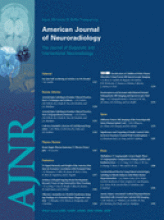Abstract
BACKGROUND AND PURPOSE: Diffusion-weighted imaging (DWI) can depict small punctate hyperintense lesions in the hippocampus in transient global amnesia (TGA). The purpose of this study was to find an optimal DWI protocol for lesion detection in TGA by investigating various imaging parameters and imaging timing after symptom onset.
MATERIALS AND METHODS: Sixteen patients with TGA diagnosed during 14 months underwent DWI within 24 hours and again at follow-up 3 days after onset. Each DWI session included 4 different sequences using different b-values (seconds per square millimeter) and section thicknesses (millimeter): 1000/5, 1000/3, 2000/3, and 3000/3. The presence or absence of hyperintense lesions on the 8 DWIs was determined visually, and the number of lesions detected was compared.
RESULTS: Thirteen of the 16 patients (81%) had either single or multiple punctate hyperintense lesions, totaling 24 lesions, and the remaining 3 patients had no lesions. All lesions detected were in the hippocampus except 1. The number of lesions detected on initial DWIs at a b-value/section thickness of 1000/5, 1000/3, 2000/3, and 3000/3 was 3, 9, 13, and 13, respectively, whereas that of follow-up DWIs was 17, 22, 24, and 24, respectively.
CONCLUSION: On the basis of these preliminary results, the highest lesion detection was achieved for DWI with b = 2000/3 mm or b = 3000/3 mm at 3 days postonset. When no lesion is detected by DWI within 24 hours after onset, follow-up DWI is recommended several days later.
- Copyright © American Society of Neuroradiology












